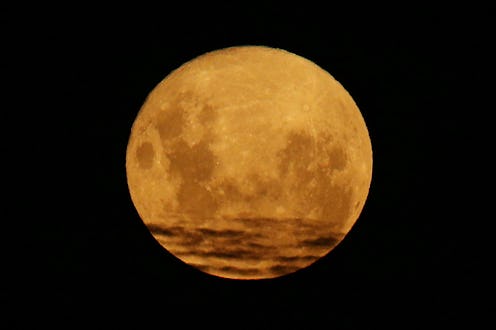Life
This Month's Full Moon Has 4 Different Names — And They Each Mean Something Different

A full moon comes once a month, and while they might all seem like the same thing - the end of one lunar cycle and the soon-to-be beginning of another - they each represent different things. Each full moon has its own name that has a special meaning behind it, and it's incredibly interesting to discover what these are. The names of full moons come from Native American tribes and are hundreds of years old, and each one tells a story. So what is the July 2018 full moon called? There are actually two names for this one, and each one tells us a lot about the season we're currently in.
Native American tribes obviously didn't have calendars like we do today, and so to keep track of the seasons, they used nature — specifically the moon. Ancient tribes took note of seasons by following the lunar moon instead of the solar year. They named the moons after features they associated with the Northern Hemisphere seasons.
The July full moon is most commonly known as the Buck Moon, which refers to the fact that a buck's antlers are in full growth mode at this time of the year. Time and Date says, "Male deer, or bucks, shed their antlers and grow new ones every year. Deer belong to the Cervidae family along with elk, moose, reindeer, and other species. There are several different species of deer in the US and Europe, where this traditional Full Moon name originated."
This actually isn't the only name for this full moon. It's also known as the Thunder Moon, because thunderstorms are so common at this time of the year.
Lastly, Time and Date says that it can also be known as the Hay Moon "after the hay harvest that takes place in July" or the Wort Moon, "indicating that July is the time to gather herbs (worts) to dry and use as spices and remedies."
This month's full moon is extra special, because it's also a total lunar eclipse (also called a Blood Moon) and a micro full moon. A total lunar eclipse refers to the moment that the Earth's shadow completely covers the moon. The total eclipse in July is a special one because it will be the longest lunar eclipse of the century - so if you're going to see one, you might want to make it this one! Unfortunately, the total lunar eclipse won't be visible for those of us in the Northern Hemisphere. It's only going to be visible in the Eastern Hemisphere, like Asia, Australia, New Zealand, and much of Europe and Africa.
Many refer to a total lunar eclipse as a "blood moon," because of the coloring of the moon. When the moon passes into Earth's shadow, it appears to be a rusty or reddish shade, which is where the name comes from. Again, though, this coloring will only be visible to those who will see the total lunar eclipse, so for those of us in the United States, the moon will be its normal color.
While those in the Eastern Hemisphere will see the Blood Moon, we'll see a micro moon. This is pretty much exactly what it sounds like: the moon is going to look tiny. That's because the center of the moon is at a place in its orbit where it's farthest from the Earth. It's going to appear about 15 percent smaller than a super moon, and it's also going to be about 30 percent duller. It's a difference you'll notice if you pay a lot of attention to the moon.
So now you can mark your calendars: on Friday, Jul. 27, you'll see the Full Buck Moon rising at 4:20 p.m. EST, and you might notice that it's a little smaller than usual.